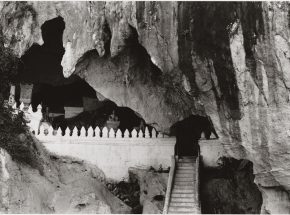

Born in Boston, MA, 1973. Lives and works in Providence, RI
1997 B.F.A. in Film/Video/Animation, Rhode Island School of Design, Providence, RI
Ara Peterson’s arresting three-dimensional objects fall somewhere between painting, sculpture and architecture. The somewhat outmoded practice of a ‘bas-relief’ comes to mind, but this type of ornamentation doesn’t fully capture the voluptuousness of these structures, which are as much about optical clairvoyance as they are about process. Indeed, each piece results from a series of labor-intensive operations, beginning with the synthesis of wave formations that translate the artist’s initial mental image into a basic form. This is an impressionistic use of algorithms to determine the cutting of wooden slats, which are then hand-painted and assembled into unique volumes that are perhaps most simply described as passageways into new visual intensities. It is tempting to filter Peterson’s geometric abstraction through the logic of the digital. In his hypnotic striations, some may detect the pattern of white noise, or the undulations of the computer screen. Though technology is instrumental (at least as much as a brush to a painter), the end result has more to do with Minimalism’s early dictum: “singular forms sometimes repeated.” Rather than binary code, the pseudo-automated fabrication of each piece speaks to the seriality of Donald Judd, or perhaps, most vividly, the quadratic elaborations of Sol Lewitt as in Open Geometric Structure, 1990, also made from painted wood.
The ingenuity of Peterson’s practice lies in his ability to revisit this modular logic, but within a different context. This is perhaps the most fundamental aspect of the work, and the underlying link to his ground breaking film and video work as part of the Providence- based collective, Forcefield. Combining hypnotic effects with real time pageantry and craft, these early video pieces are assembled from modular fragments and singular units reconstituted through the flexibility of digital editing. This is the case with a spectacular piece such as Ultra Violence, 2003, with its unrelenting visual assault using isolated clips from horror, sci-fi and slasher films. Sixties flashbacks aside, the sensory overload of these environments are attempts to grasp and transcend the contemporary technocratic delirium. This is pushed even further in later works that generate their graphic outlines from specially prepared, stripped down video clips. Here, un-traceable motion on screen is literally transposed as a sculptural foundation, and resulting works like Standing Waves and Weird Zebra attest to the re-materialization of a seemingly intangible logic. In this sense, Peterson’s work is very much about perception and altered states as they come against new material regimes. If this is the case, he may not be so far removed from his other predecessors in Op Art and Neo Geo who turned to geometric abstraction to explore shifting modes of seeing. Certainly, there are glimpses of Bridget Riley and Marina Apollonio in the flickering of his compositions and the virtuosity of his pattern; perhaps also in the retinal games that make the individual pieces seem to move, or appear weightless and immaterial before the viewer. But Peterson dissipates these visual tricks as much as he plays with them, and the works exist in constant flux. Ultimately, the surface razzle-dazzle becomes marked by its own materiality as closer inspection reveals slight variations in the wood and the application of paint that renders each module unique and singular. Granted this its own type of optical effect, but of a different order, for within the tightly controlled constraints of pattern and repetition, the idea of irregularity takes on poetic import, which Peterson deploys to achieve an unexpected, emotive tension. It is tempting to call this is ‘the hand against the pixel, but Peterson seems less interested in this opposition, than simply tracing the modulation of perceptions as it shifts across time and space. In this sense, the project comes upon an unexpected historical legacy: that of the post-impressionists. If you look long enough, J.W. Turner and his experiments with color and retinal after images emerge in a piece like Golden Tube, a circular construction which seems to revisit 1843’s Morning after the Deluge. The effect is a funny type of historical vertigo, which unearths the unexpected convergences of genealogies as they flutter in and out of perception.
— Franklin Melendez
